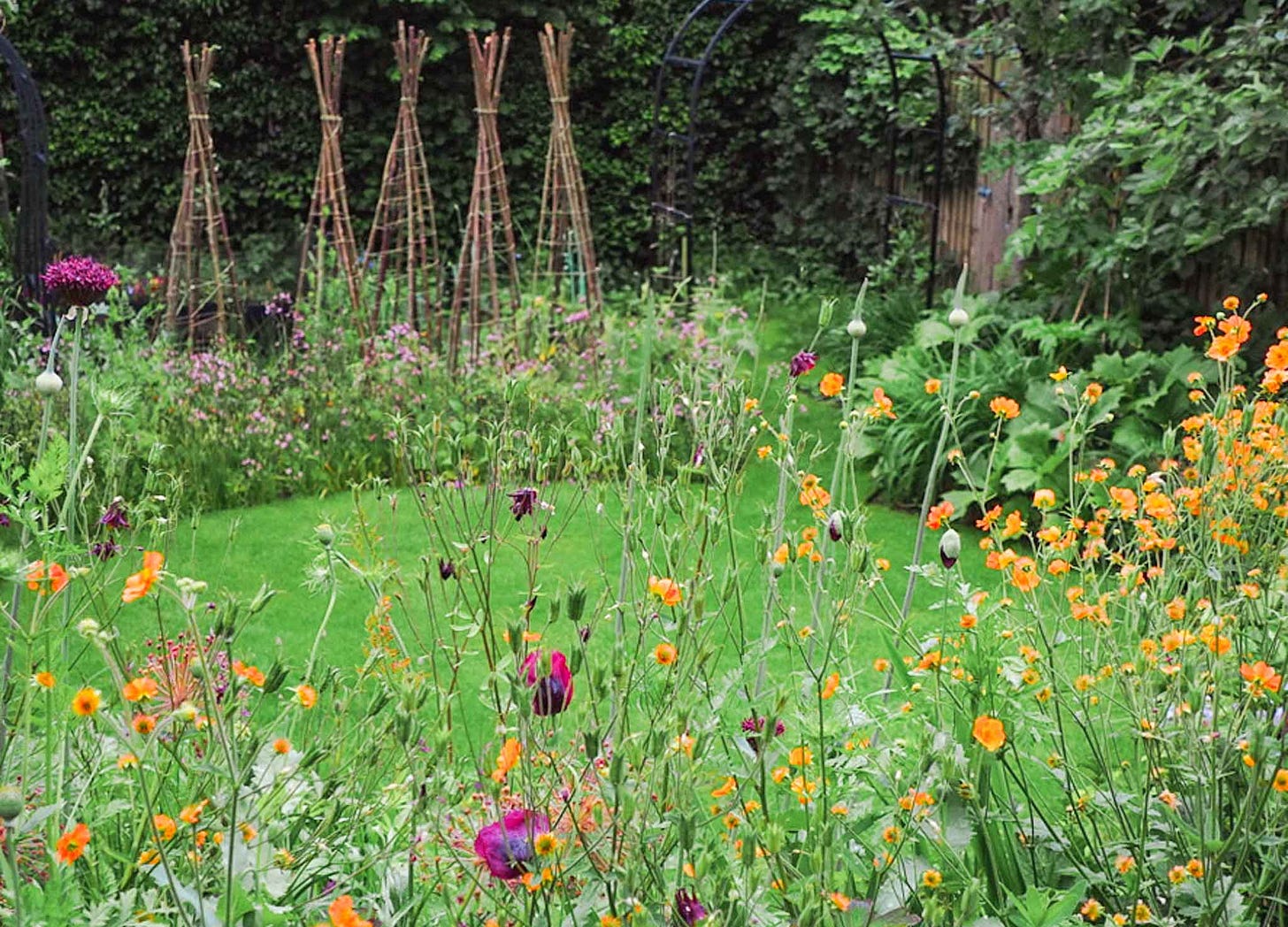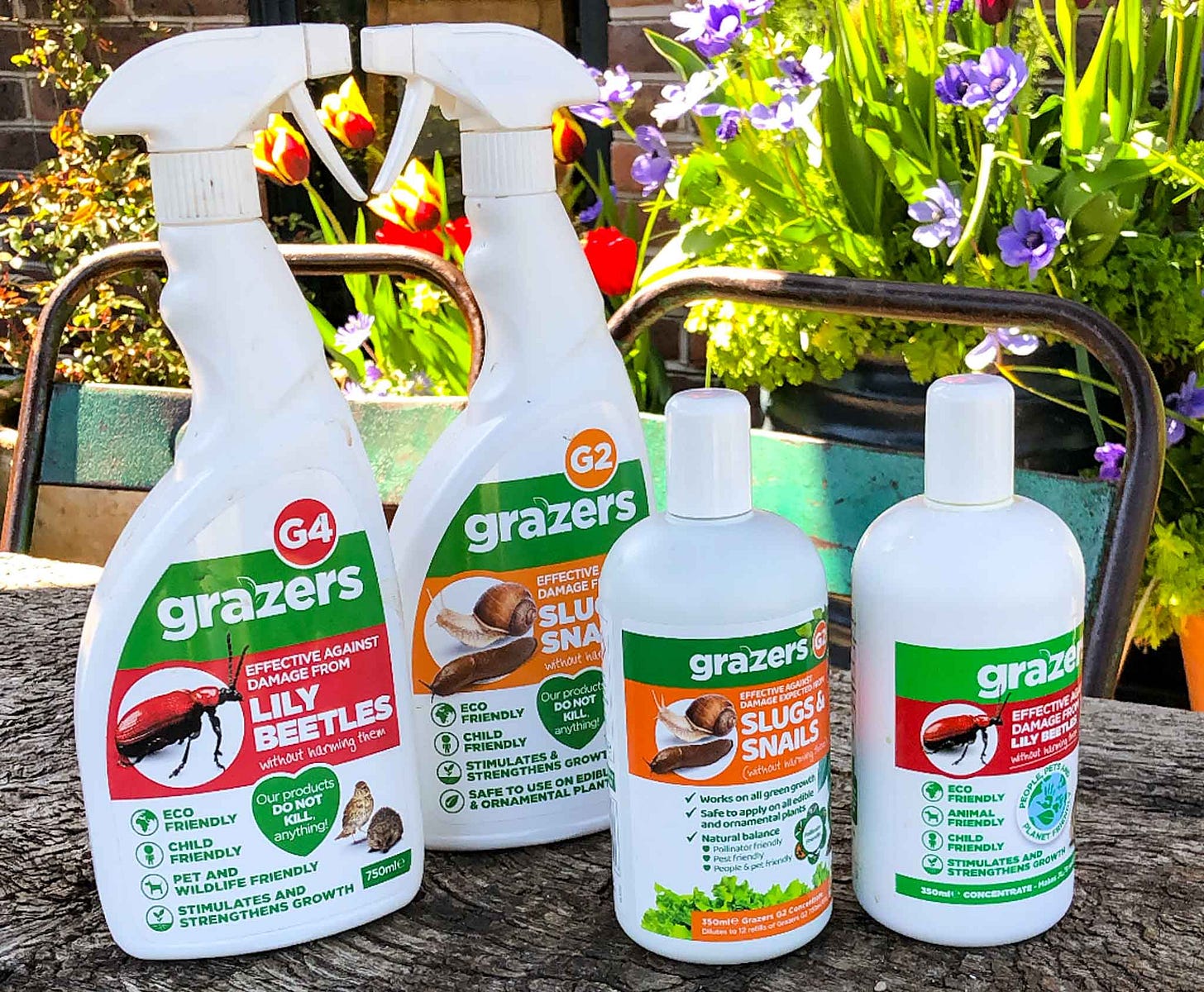Nature’s early risers wake me at 4.30 am, with birdsong drifting through the open-all-summer windows. Cocooned in the fluffy clouds of my bed, I savour the sound happily in the soft morning light, eyes still closed.
By the time my ACTUAL 6.30 am alarm buzzes, I’m mentally already in my garden, wondering what new blooms will be open when I dash outside, for me and the bees (shouldn’t there be MORE of them?) to enjoy. My weekend to-do list of garden jobs is already shaping up in my mind.
June is a horticultural heaven for us gardeners, with sunlight lingering until nearly 10 pm, and our gardens bursting with life and colour. Now is the time to savour every moment spent outside, hands in the soil, head in the light.
Evening Pottering: My Gardening Bliss
I could easily tick a few of June’s jobs off my list when I return from work each evening, instead, I prefer to potter. I water what needs it, deadhead here and there, swing in my hammock and immerse myself in the luxury of these balmy evenings we’ve longed for all year.
My trick to stop the itch of some serious gardening graft? NOT to change from my work skirts and sandals – the risk of soil in one’s Birkenstocks or stains, worse still rips, in my daytime garb keeps me from veering more deeply into the borders than a front edge weed hoik allows for. This means that I can enjoy the peace of it all, connecting with nature peacefully after a long day – though I'm not above sprawling on my round of lawn for a spot of relaxing cloud-gazing!
The roller coaster spring and early summer weather is ALMOST forgotten as summer settles in. Now the sun and I, have both put our hats on, weekends now bring the blissful opportunity to roll up my sleeves (short) and wear double glasses (sun and reading – both essential these days) for a few hours of gardening joy. I look forward to this bliss all week.
At last, Gertie the greenhouse stands cleared, my spring-sown seedlings are starting to thrive, and the early summer perennials are at last beginning to put on a show. I finally feel I’m kind of on top of things.
That’s not to say there aren’t June jobs to tackle if, like me, you can’t bear NOT to get your hands dirty, to nurture hope and relish the exercise too. Shall we dig in?
The Art of the (belated!) Chelsea Chop
Sudden heat accounts for the rise in lanky stems and floppy perennials in my borders even though I managed to stake almost everything I wanted to. I’d prefer at least some of my plants to be more compact with a longer season of bloom. So, I carefully prune select clumps of my perennials – I know this feels completely counter-intuitive, but honestly, I can't help but feel a sense of anticipation, knowing that I’m extending the flowering season and saving myself from border disarray! Believe me when I say that slight panic about potentially sacrificing flowers melts away with each strategic snip!
The Chelsea Chop, typically done in late May (coinciding with the Chelsea Flower Show) involves cutting back by about one-third the height of late-flowering perennials like sedums, rudbeckias and asters. The result? Sturdier plants, a more compact habit and a longer flowering period.
I've been experimenting with partial chopping – trimming only the front half of a clump or every other stem. This creates a tiered effect and staggers the blooming time. Late to flower, though my helenium, veronicastrum and Cephalaria are usually beheaded earlier in the year, mine are getting this treatment this weekend and I can't wait to see the results.
Then there’s the Hampton Hack!
The Hampton Hack (this time coinciding with the RHS Hampton Court Flower Show) sounds more aggressive and indeed it is! Plants that have flowered look tired and straggly, so are cut pretty much down to ground level to promote fresh, green growth and often a new flush of flowers. Feeling apprehensive the first time that you do this is normal. Hold your nerve, cut back the whole plant, and in a week or so young foliage and flower buds will be replacing the mess you have removed.
Many of my geraniums, alchemilla and astrantia have reached that ‘crazed’ stage which reminds me of someone who’s perhaps stayed that bit too long at the party, and within a couple of weeks they all seriously benefit from your bravery with the secateurs - often the results are nothing short of miraculous! TIP: Though not essential, I like to give plants a good soak after their early summer haircut.
Pest Management: A Gentle Approach
New foliage arrives hand in hand with new visitors to the garden, some of them more welcome than others! Aphids seem to be having a field day on my roses while lily beetles are mounting a determined assault on my lilies.
I’m trying to consider that the presence of pests is actually a backhanded compliment – that they’re drawn to my healthy plants which look good and to them at least, taste delicious. Nature knows good food when it sees it.
Pests are an integral part of the growing cycle. They’re all part of the chain and biodiversity in the garden is truly a good thing. I truly believe that we should be welcoming all forms of life into our gardens, but honestly? There is a limit. Rather than reaching for chemical solutions, I choose to take a multi-pronged, eco-friendly approach:
My lilies are inspected on my evening perambulation, the scarlet beetles plucked manually, and their offspring sprayed off with a sharp blast from the hose. Now the rain has stopped, I also reach for the Grazers Lily Beetle spray. Environmentally friendly, and killing nothing, this concentrated solution of calcium and pyrethrum (nature’s insecticide), the spray renders foliage unpalatable to lily beetles and larvae, essentially cloaking my plants with invisibility!
If you have flowers in your garden, there’s no doubt you’ll have aphids too. Aphids are sap-sucking insects crucial to many food chains. Typically they cluster on flower stalks just as they come into bloom. Now, while their numbers can give people the ick, aphids rarely prove fatal to plants. They may distort buds or leaves and can spread viruses or cause honeydew buildup, but these issues are easily sprayed away with water or wiped off with a cloth. You don’t HAVE to kill or control them. When they get too much for me, I simply blast them with a hose.
For those dealing with slugs and snails, remember those nematodes I mentioned in spring? Now's a great time for another application if you haven't already. I’ve also dug out my copper slug rings and now have an encircling barrier around my most precious dahlia!
Mulch Mania and Watering Wisely
With summer heat building, mulching becomes crucial. I spread a layer of fine composted bark and my treasured garden compost over my borders back in late winter, but here and there I’m topping it up where it’s needed to lock in moisture and keep the weeds down with the bonus that it gradually feeds the soil as it breaks down.
Speaking of moisture, June often brings the challenge of keeping the garden hydrated. Here are my top watering tips:
Water deeply and less frequently to encourage deep-root growth
Focus on the base of plants rather than watering the leaves.
Make sure to water your pots once or twice a day – use a moisture meter (or your finger) to check if your pots need it. Not forgetting that wind can be just as desiccating as sunshine.
Water in the early morning so the plant has a chance to soak moisture up. That said, I often have no choice but to water in the evening, but always kick myself as in a year when slugs are prevalent, I’m sure this aids their nightly attacks – I found SEVEN munching my Dahlia ‘Waltzing Mathilda’ last night on my head torch patrol!
Use a washing-up bowl and an Eco washing-up liquid. Once your pots are done and the water is cool, it can go straight into your containers. I subscribe to Bower Collective’s refillable Eco & Non-Toxic Washing Up Liquid – lots of their other products too!
Dreaming of Dahlias
June is when my dahlia obsession kicks into high gear. The tubers I potted up in April are now becoming sturdy plants and every day I’m cheering them on as they grow. Any that have taken a battering by the molluscs now have copper slug rings around them to protect them from the munch.
This year, I'm particularly excited about:
Dahlia 'Bright Eyes': New to me, with gorgeous foliage so far. I'm looking forward to vibrant pink-purple single, prolific blooms.
Dahlia 'Thomas A. Edison': Deep purple blooms that add drama to the border. I can't believe I haven't grown this classic before!
Dahlia merckii: A late addition to my naughty spends. I've given this hardy species border space – a first for a dahlia here! Towering 3-inch blooms in shades of pink should be with me soon.
Dahlia 'High Fidelity': Apricot orange with a red petal reverse. Though I usually prefer pollinator-attracting singles, I couldn't resist this newly debuted ball variety!
TIP: Remember to pinch out the growing tips when your dahlias reach about 40cm tall to encourage bushier growth and more flowers. Make sure they’re supported with metal hoops, rings or bamboo and twine.
June's Garden Checklist: Your Must-Dos and Don'ts
I have to say, I love a quick garden job, those five or ten minute tasks that quickly become part of your gardening routine. They get me out into the garden each morning which is the best start to the day, isn’t it?
Here's a quick rundown of what to focus on this month:
Must-Dos:
Water, water, water! With summer heat building, I’m paying special attention to newly planted seedlings, direct sown and newly planted out, container plants and anything that’s seriously flopping!
TIP: keep your watering cans filled up so they’re ready to go.
Dedicated deadheading: I find this task deeply meditative – a perfect excuse to spend time admiring your plants up close, with the added benefit that regular deadheading encourages more bloom.
Supporting role: I have a stash of hoops at the bottom of my garden ready to support plants that need it. I've almost finished staking my sunflowers, tying a figure-of-eight knot with twine between the stem and the bamboo cane. I have maybe a dozen left to do.
It's also the perfect time to start biennials like foxgloves and wallflowers for next year's display. My favourite seed supplier, Chiltern Seeds, have a great biennial list to sow now (not a paid ad, or affiliated in anyway, just genuinely love them!)
Feeding Friday: Every Friday morning, I feed my plants before I get dressed for work. I opt for Natural Grower's organic, vegan liquid feed or the fertiliser that my wormery produces to give my container plants and annual the nutrients they need to thrive. This weekly ritual helps them resist pests, and diseases and produce more bloom or veg. I adore this quiet garden time, and it keeps my weekends stench-free!
TIP: I have a discount code for you! Use MYREALG15 for 15% off on all Natural Grower Products. CLICK HERE to shop.
Don'ts:
Don't forget to harden off: If you're still planting out tender annuals or vegetables grown inside or in your greenhouse, tempting though it is not to bother, remember to acclimatize them gradually to outdoor conditions. Bitter experience shows me that if you don’t – instant scorch followed by death (of your plants not you!)
Avoid overhead watering: Especially in the heat of the day. This is such a waste of water, and though the scorched leaved theory has been disproven, the quick spray with a hose will barely water your plants, instead encouraging fungal diseases.
Parched plants: If you have a greenhouse, ensure it's well-ventilated by opening a window, vent or even leaving the door open. If it gets SUPER hot, consider whitewashing your greenhouse roof to provide shade, as overheating can seriously stress your plants.
Resist over-mowing: In hot weather, avoid cutting your lawn too short. Slightly longer grass is more drought resistant.
Don't disturb nesting birds: Be cautious when trimming hedges. Our feathered friends might have made their homes there!
In my next newsletter, I'll share my favourite gardens, products and plants from the RHS Hampton Court Flower show, I’m there all weekend judging the Get Started Gardens. In recent years the show certainly has a festival vibe and I for one can’t wait to plunge myself into it!
Meanwhile, I'd love to hear from you! Have you tried the Chelsea Chop or Hampton Hack? Perhaps you've found an ingenious way to outsmart those slugs? Or maybe you're nurturing a dahlia variety that's stealing the show?
I hope you've enjoyed this month's free My Real Garden newsletter edition. My goal is simple: to share everything I've learned from my own garden and the countless others I've designed in the UK and abroad. If my musings inspire just one person to try gardening, it brings me immense joy.
If this virtual gardening potting shed has inspired you, perhaps you might consider becoming a paid subscriber to My Real Gardens.
For less than the cost of a packet of seeds per week, paid subscribers receive:
- Three exclusive posts monthly
- Early insights into emerging gardening trends
- The opportunity to ask specific garden questions
- Ad-free, spam-free content directly in your inbox
By becoming a paid subscriber, you're not just unlocking premium content; you're actively supporting My Real Gardens' growth and quality. Your support allows me to dedicate more time to creating the content you love. It's an investment in our shared passion for gardening and our growing community.
Simply click the subscribe button below for a 7-day free trial. Your support helps this garden of ideas flourish, and together, we can continue to grow our knowledge and passion for gardening.
Happy gardening and thank you for being part of our community.












I love your style of writing. I only have a deck at the moment. My foxgloves in their large containers were decimated by the wind and thunderstorms we have experienced many days over the last two weeks. I'm going to try the Hampton Hack today. I've also been saving the seeds.
I have been Chelsea Chopping and Hampton Hacking for years….. so worth it…..especially Achillea Sedums and Phlox…… must buy more composted bark for the Acer border..to lock in that moisture…thanks for the reminder…💚💚💚